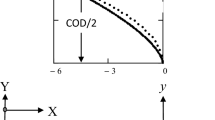Abstract
Within the linear viscoelastic theory, crack tip fields are calculated at various crack tip velocities. A transition from rubbery to glassy material behavior in the vicinity of the crack tip can be observed. Shear and bulk behavior is analyzed separately. Whereas the increase of tearing energy at higher crack tip velocities can be ascribed to the shear behavior, bulk behavior influences the fracture mechanism. The results support experimental investigations that the instability separating stable from unstable crack propagation is related to a change in the fracture mechanism. At low crack tip velocities, material separation is the result of formation, growth, and coalescence of cavities. At high crack tip velocities, cavitation is suppressed and fracture is driven by a rather brittle mechanism resulting in a decreased amount of energy to propagate the fracture process zone.
Similar content being viewed by others
References
R. S. Rivlin and A. G. Thomas, J. Polym. Sci. 10, 291 (1953}).
A. A. Griffith, Philos. Trans. R. Soc. London, A 221, 163 (1920).
B. N. J. Persson and E. Brener, Phys. Rev. E: Stat. Phys., Plasmas, Fluids, Relat. Interdiscip. Top. 71, 036123 (2005).
B. N. J. Persson, O. Ahlbohr, G. Heinrich, and H. Ueba, J. Phys.: Condens. Matter 17, 1071 (2005).
Z. Major, Ch. Feichter, R. Steinberger, and R. W. Lang, Fracture of Nano and Engineering Materials and Structure, Ed. by E. E. Gdoutos (Springer, Dordrecht, 2006).
K. Tsunoda, J. J. C. Busfield, C. K. L. Davis, and A. G. Thomas, J. Mater. Sci. 35, 5187 (2000).
A. N. Gent and C. Wang, J. Mater. Sci. 26, 3392 (1991).
G. Strobl, The Physics of Polymers (Springer, Berlin, 1997).
F. R. Schwarzl, Polymermechanik: Struktur und mechanisches Verhalten von Polymeren (Springer, Berlin, 1990).
T. L. Anderson, Fracture Mechanics: Fundamentals and Applications (CRC, Boca Raton, 1995).
M. F. Kaninnen and C. H. Popelar, Advanced Fracture Mechanics (Oxford Univ. Press, New York, 1985).
G. A. C. Graham, Q. Appl. Math. 26, 167 (1968).
L. B. Freund, Dynamic Fracture Mechanics (Cambridge Univ. Press, Cambridge, 1990).
T. Horst and G. Heinrich (in preparation).
J. R. Rice, J. Appl. Mech. 35, 376 (1968).
G. R. Irwin, J. Appl. Mech. 24, 361 (1957).
S. Aoki, K. Kishimoto, and M. Sakata, Comput. Mech. 2, 54 (1987).
Author information
Authors and Affiliations
Corresponding author
Additional information
Published in Russian in Vysokomolekulyarnye Soedineniya, Ser. A, 2008, Vol. 50, No. 5, pp. 882–891.
This article was submitted by the authors in English.
Rights and permissions
About this article
Cite this article
Horst, T., Heinrich, G. Crack propagation behavior in rubber materials. Polym. Sci. Ser. A 50, 583–590 (2008). https://doi.org/10.1134/S0965545X08050131
Published:
Issue Date:
DOI: https://doi.org/10.1134/S0965545X08050131




